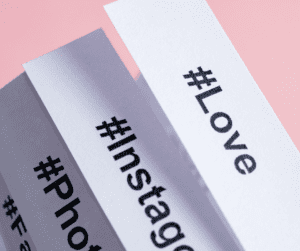Dive into a world of exposure with hashtags.
In today’s algorithm-driven society, ensuring optimization of your business’s social media channels is essential to creating brand familiarity.
One of the most effective ways to up your engagement rate and ensure your content is seen by the ideal audience is using hashtags.
A hashtag is when a pound sign is placed in front of a keyword or a collection of keywords with the purpose of populating search results into categorized content related to your interests.
When used on various social media platforms, your hashtag will be converted into a link to all content tagged using the same hashtag.
Adding the correct hashtags to your content will boost the reach of your content across audiences, helping you increase your following organically with people that have an actual interest in your product or services.
The ultimate goal behind building a strong social media following is being able to engage with brand-loyal viewers and repeat buyers.

Content Strategist, Maddy Osman said “Not only do hashtags help social media users organize and categorize content, but they’re also one of the driving forces behind some of today’s best marketing campaigns.”
Using your hashtags correctly is essential for expanding your audience organically, but how do they work?Every time a hashtag is added to your content, the post will feature on the search page of each specific hashtag.
There has always been a debate over whether hashtags should be placed in a social media posts caption or the comment section. Wherever you decide to add them should be based purely on the preference of the look of your post as adding your set of hashtags to the caption or the comment section will be equally as effective. There is currently no physical evidence proving one is better than the other. Adding hashtags to your caption does, however, give you the bonus of being able to edit them at a later stage.
Instagram currently allows you to add up to 30 hashtags to one post, but this isn’t necessarily the best practice for gaining exposure. Being more selective with your hashtag choice by only using hashtags relevant to your brand, has been proven to be more effective.
Figuring out the right amount of hashtags to use for your brand will require some testing.
While hashtags allow a post to be filtered through the vast amounts of competing content uploaded globally every second, it’s important to consider the type of hashtag you’re using so you know where your post will be seen.
Below are 5 different categories a hashtag could fall under:

Opting for a combination of categories when selecting your hashtags will give you the reach of high, medium and low competing hashtags, allowing your brand to appear in each filtered search, maximizing your exposure.
When searching for hashtags on Instagram, you’ll be able to view exactly how many posts have used the same hashtag as well as other relevant hashtags that are currently trending.
When using hashtags, it is vital to consider the audience you’re trying to reach.
The intention behind creating a presence on social media should be to build an engaged following of people with a genuine interest in what you have to offer. With that in mind, adding unrelated hashtags to your content purely because the hashtag is trending will most likely lead to views with no real action.
If you think of yourself as a social media user, the likelihood of you following a particular page because you relate to most of the content or it is in line with your interests would be quite high and as a result, you’ll probably find yourself gravitating towards and engaging with an account like this when scrolling through your social media. Consider the same mindset for your business and the following you’d like to focus your marketing efforts on.
Building a hashtag strategy around the interests of your target audience is crucial.
Explore the hashtags used by your competitors, associated influencers and other accounts related to your industry and start interacting with them and their engaged audience members.
Don’t underestimate low competing hashtags! Hashtags that show a small number of posts may be less popular, but with fewer posts to compete with, your content will stand out.

On Instagram, people are able to follow hashtags, meaning if you have used a hashtag in your post that a viewer is following, your post could show up on their feed even if they are not following your page.
Creating a branded hashtag is a simple but very effective way to promote your brand or marketing campaign. Adding your branded hashtag to your Instagram bio is an easy way to encourage your audience to create user-generated content for your brand that can be featured on your page.
Last but not least, take advantage of your social media insights.
If you’re operating a business Instagram account you will have access to its content insights. This information will not only help you optimize your page but will tell you exactly which elements need fine-tuning to yield the best results.
Your page insights are the key to your target audience wants and needs, providing you with information like how many impressions you received from a hashtag. Having access to this feedback will help you figure out the most effective hashtag strategy specific to your business, ultimately increasing your reach, engagement and following in the process.